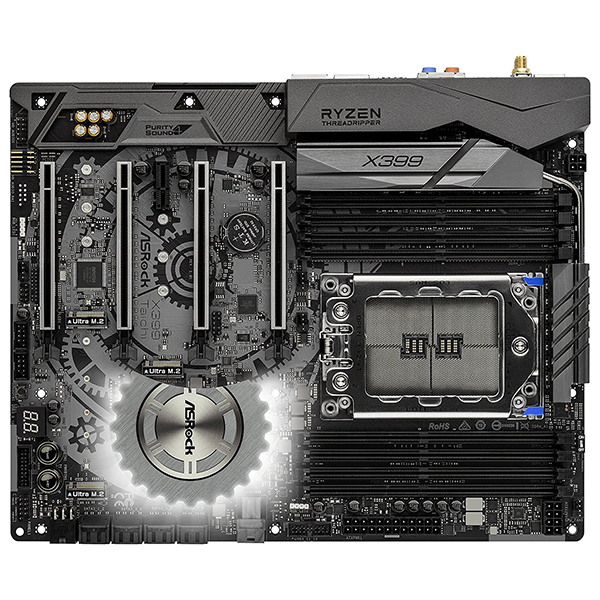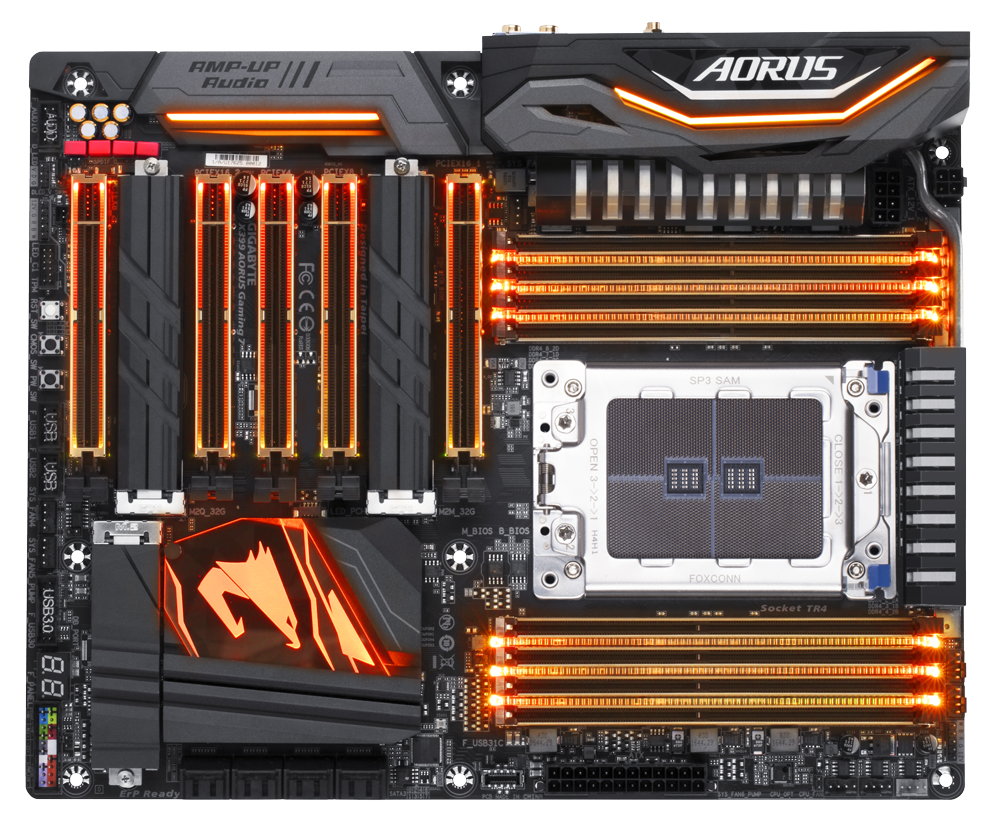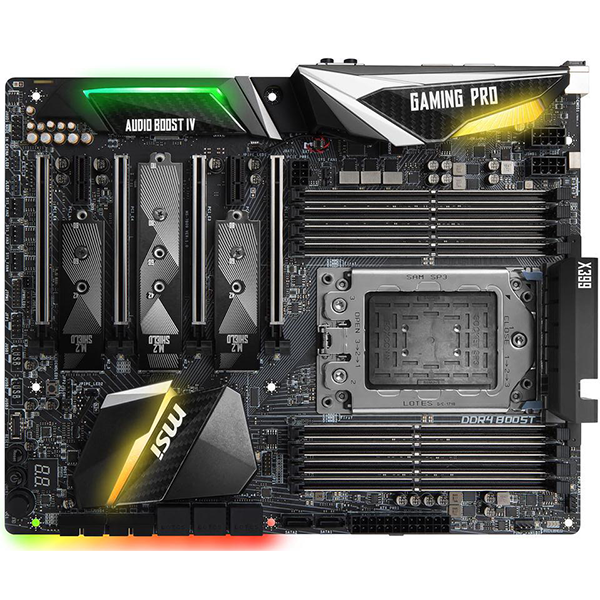ASRock X399 Fatal1ty Professional Gaming Motherboard Review: More Pro than Gaming
Why you can trust Tom's Hardware
Synthetics, Applications & Games
Comparison Products
Synthetics and Applications
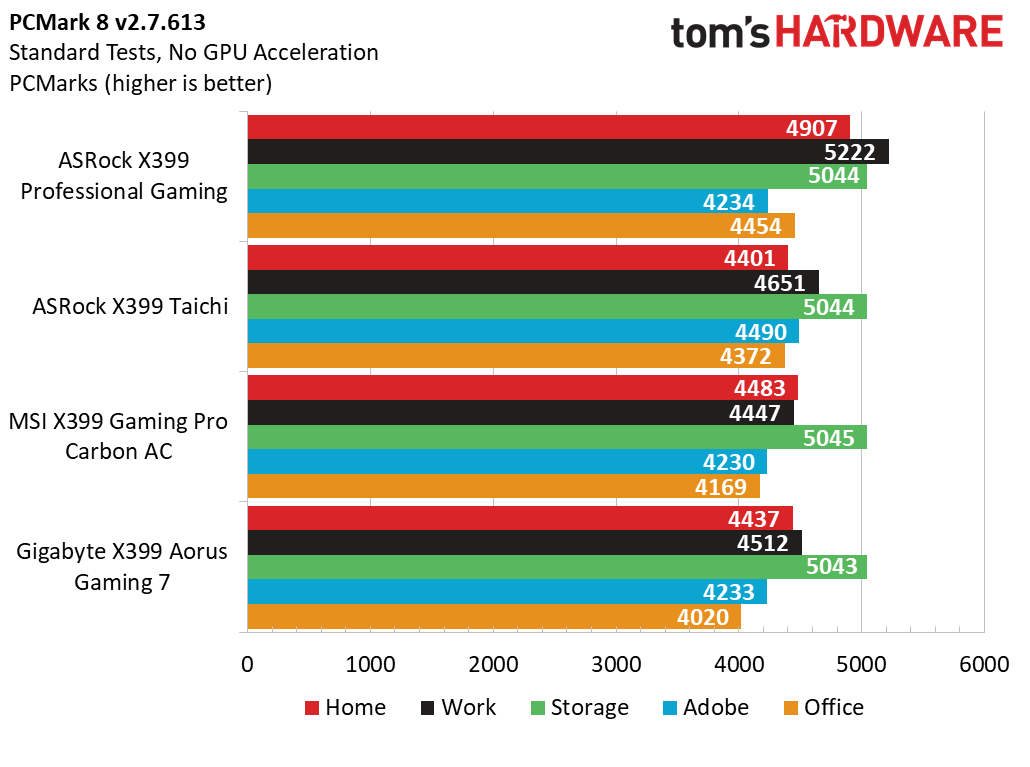
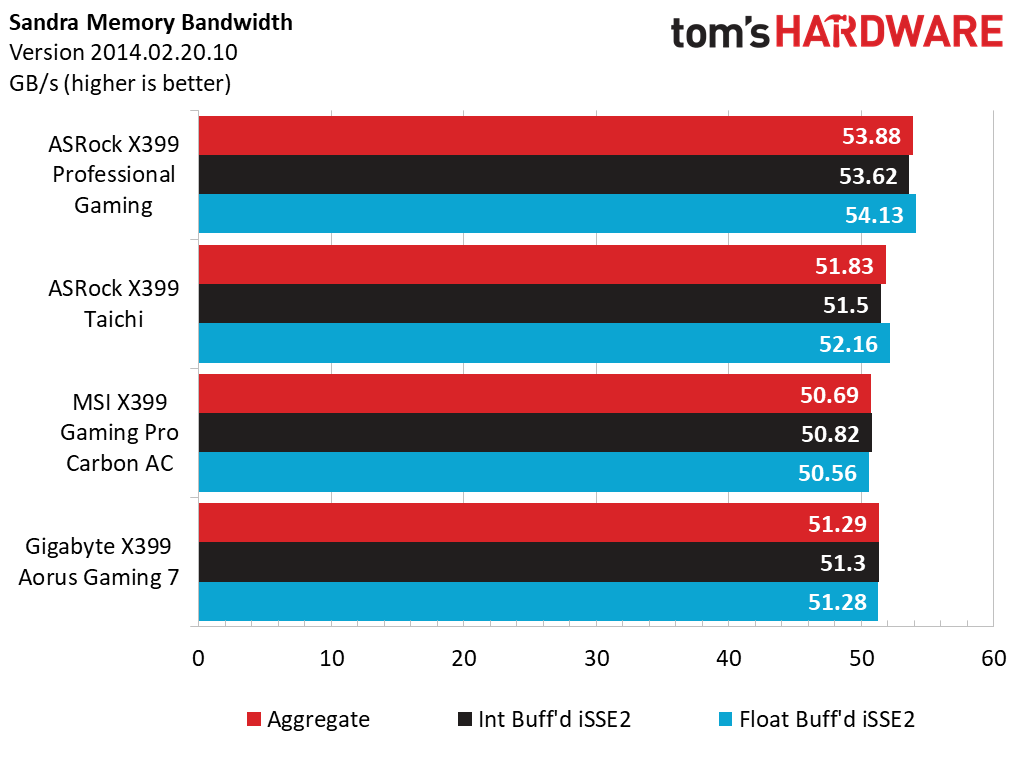
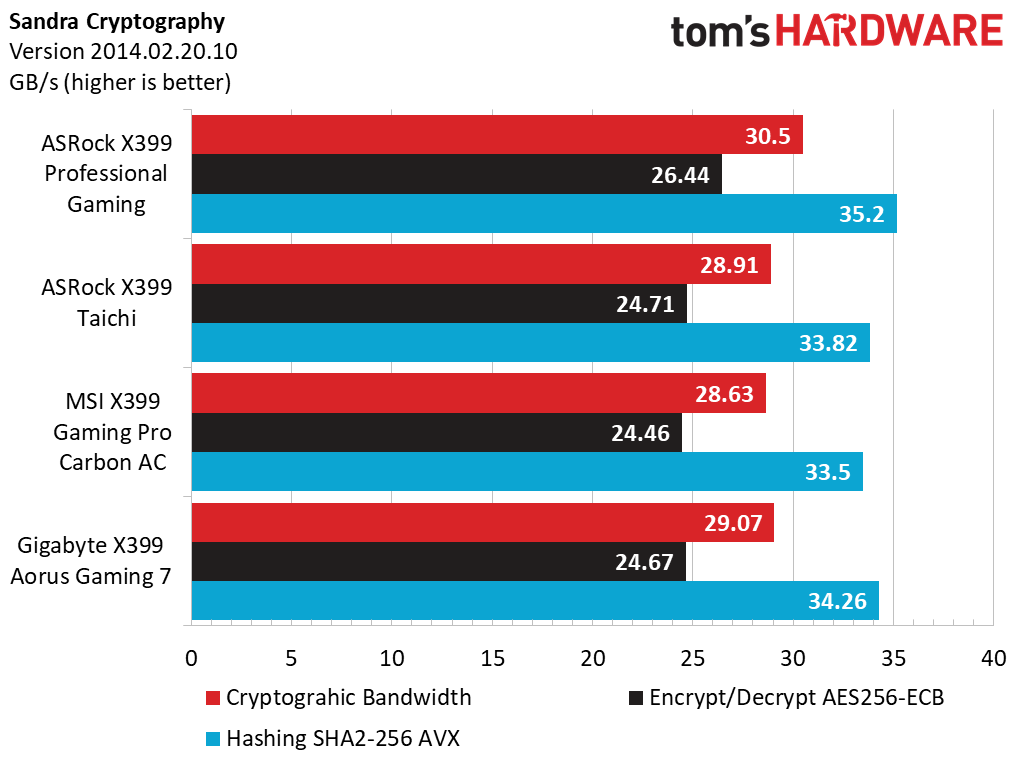
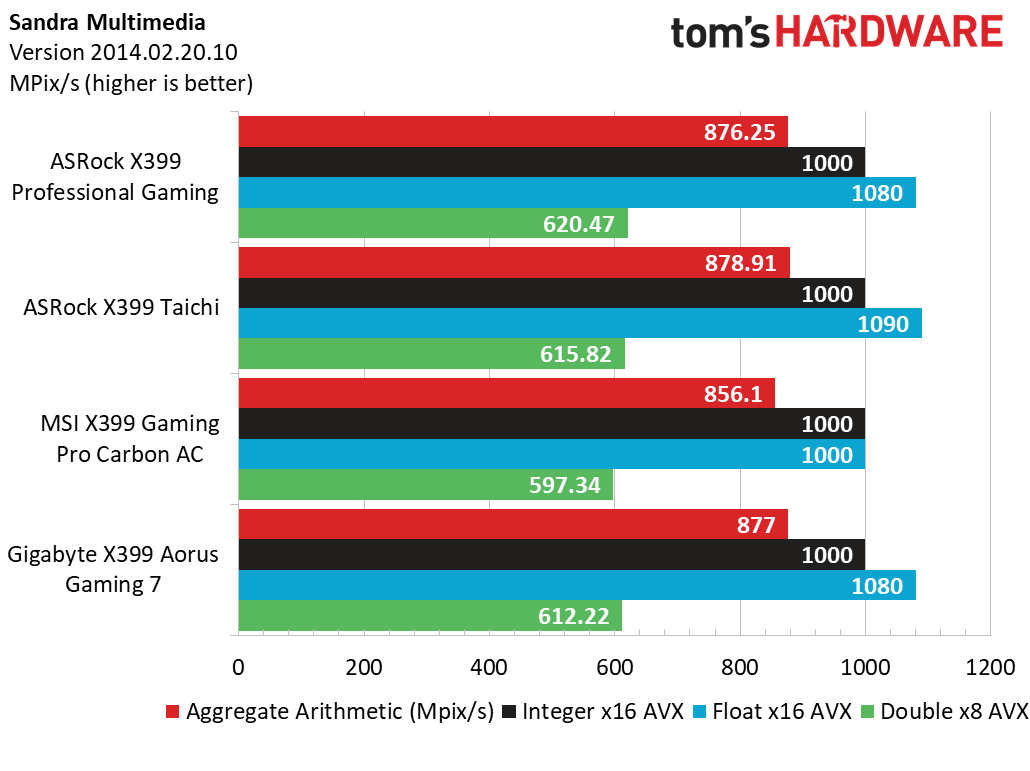
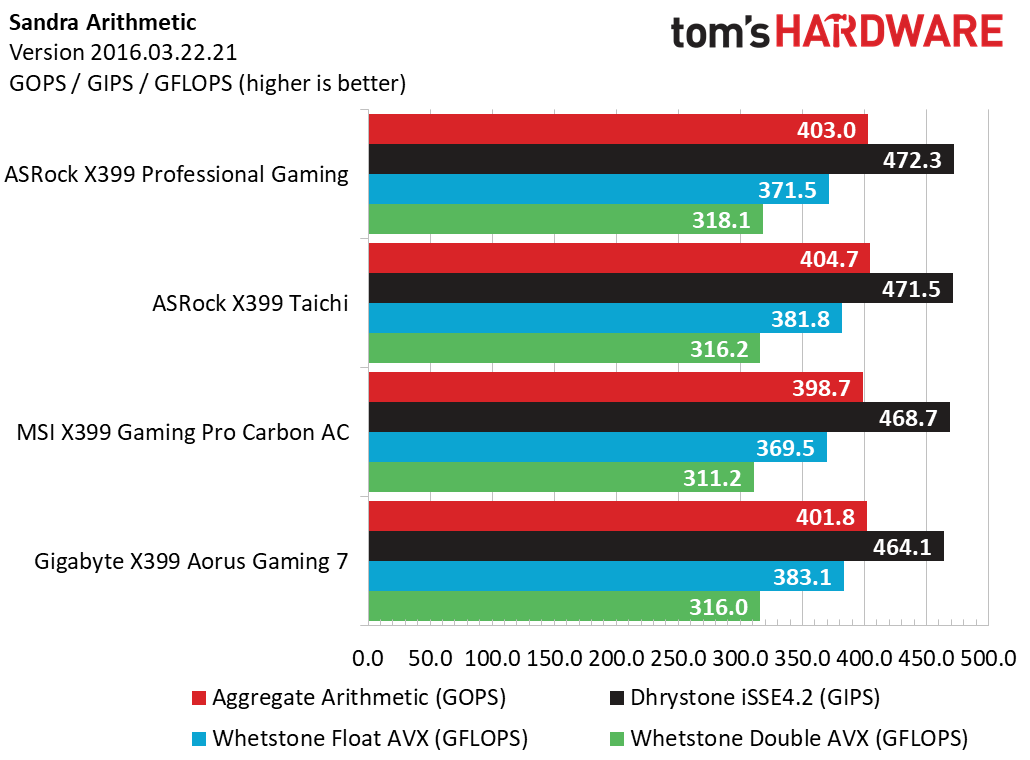
Typically, synthetics on this platform are fairly mundane. But right out of the gate, the ASRock X399 Professional Gaming surges ahead in PCMark, with impressive margins compared to all of the competitors. Sandra also plays well with the Fatal1ty board, with strong performance in all workloads. The Taichi also shows impressive results, indicating that the ASRock boards perform quite well for the prosumer crowd.
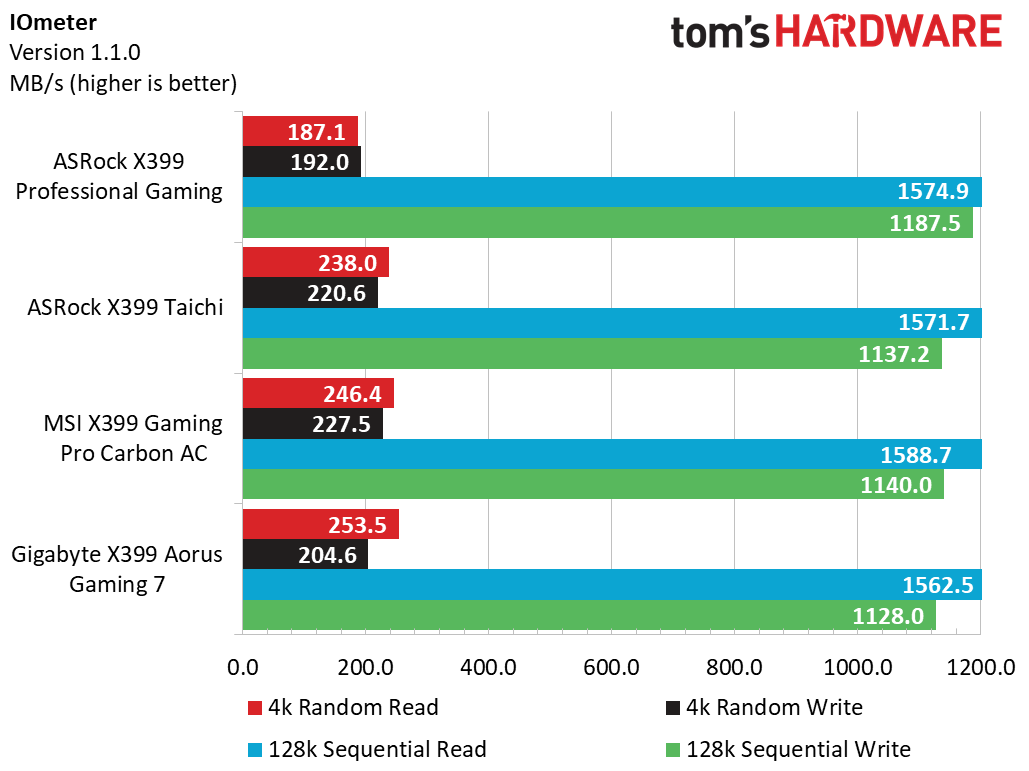
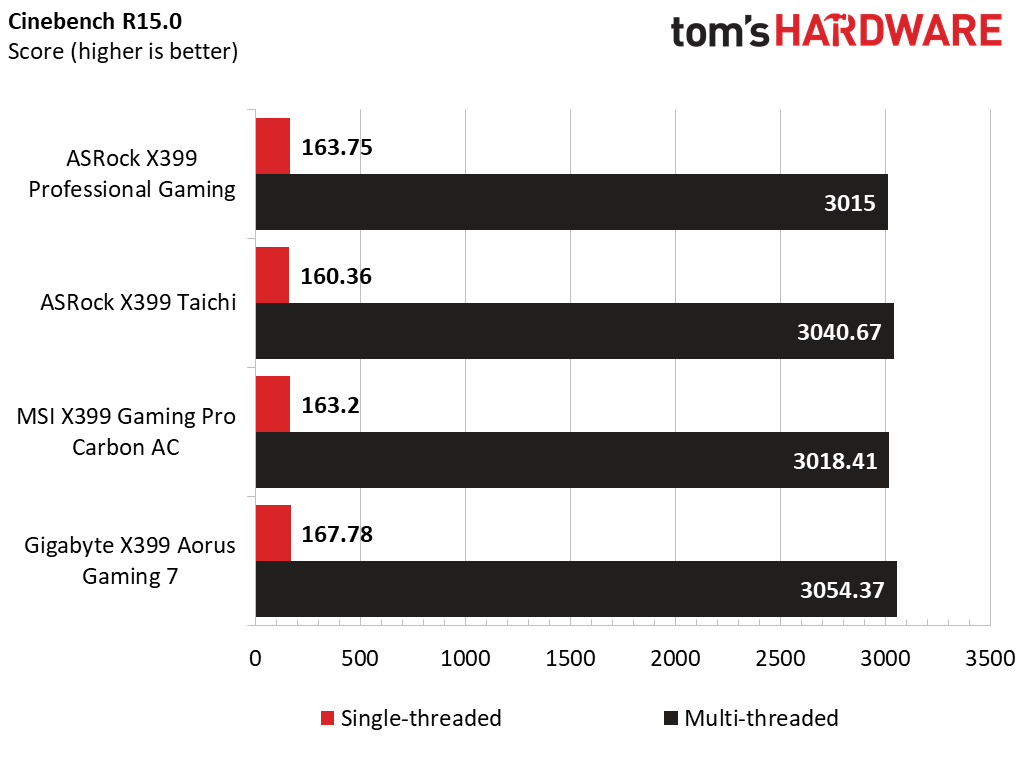
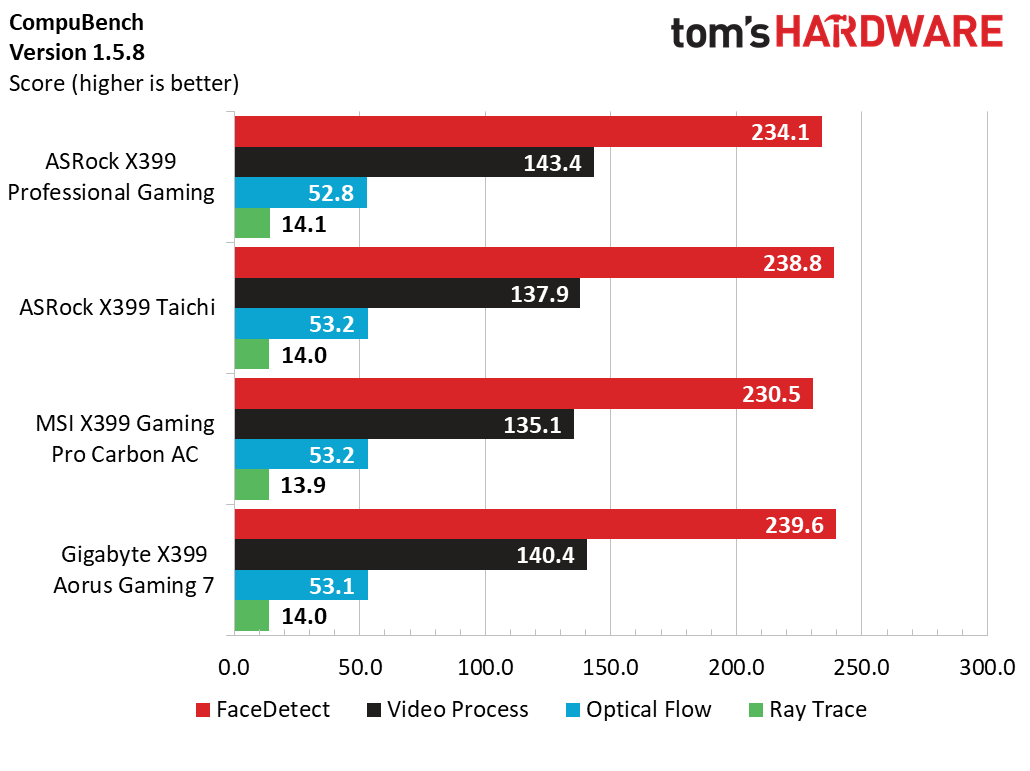
Looking at disk performance with IOmeter, our random reads and writes take a hit on this Toshiba RD400, which has roughly 75% of its rated endurance left. Mixed results are seen with Cinebench, where we observe average single-thread performance. But our multi-thread performance takes a subtle hit. CompuBench starts to shift more towards the GPU compute performance of the system and the ASRock X399 Professional Gaming trades wins with the MSI X399 Pro Carbon AC in various tasks. Honorable mention goes to the Gigabyte X399 Aorus Gaming 7, as it lands in second place in all but one instance in this workload.
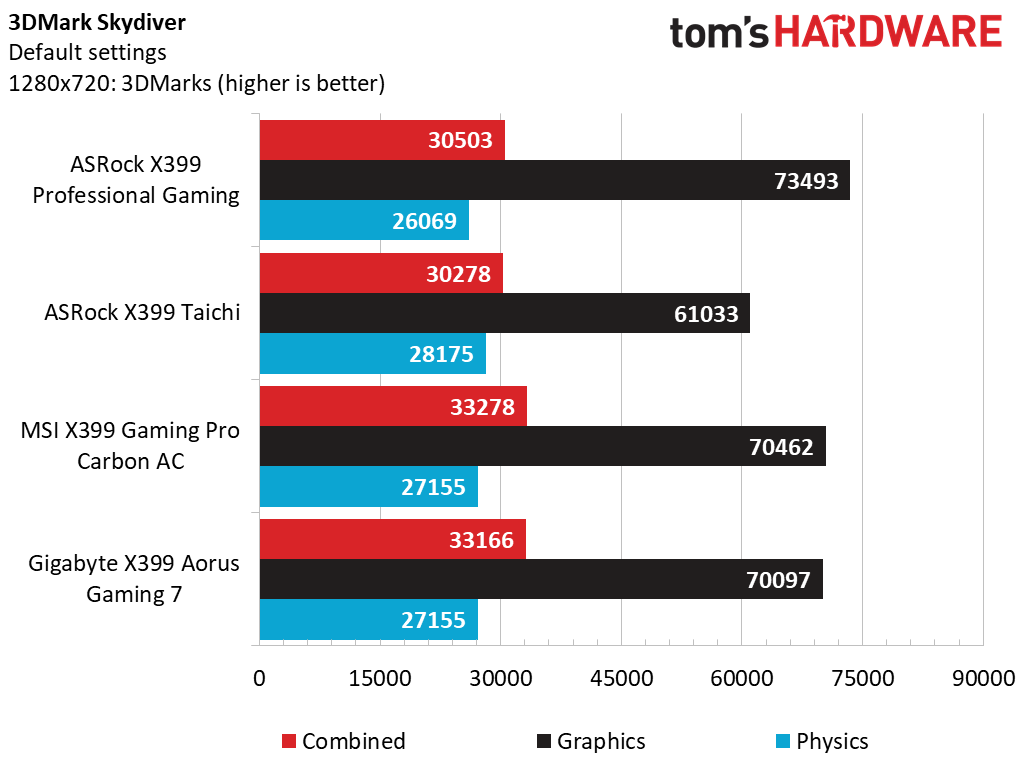
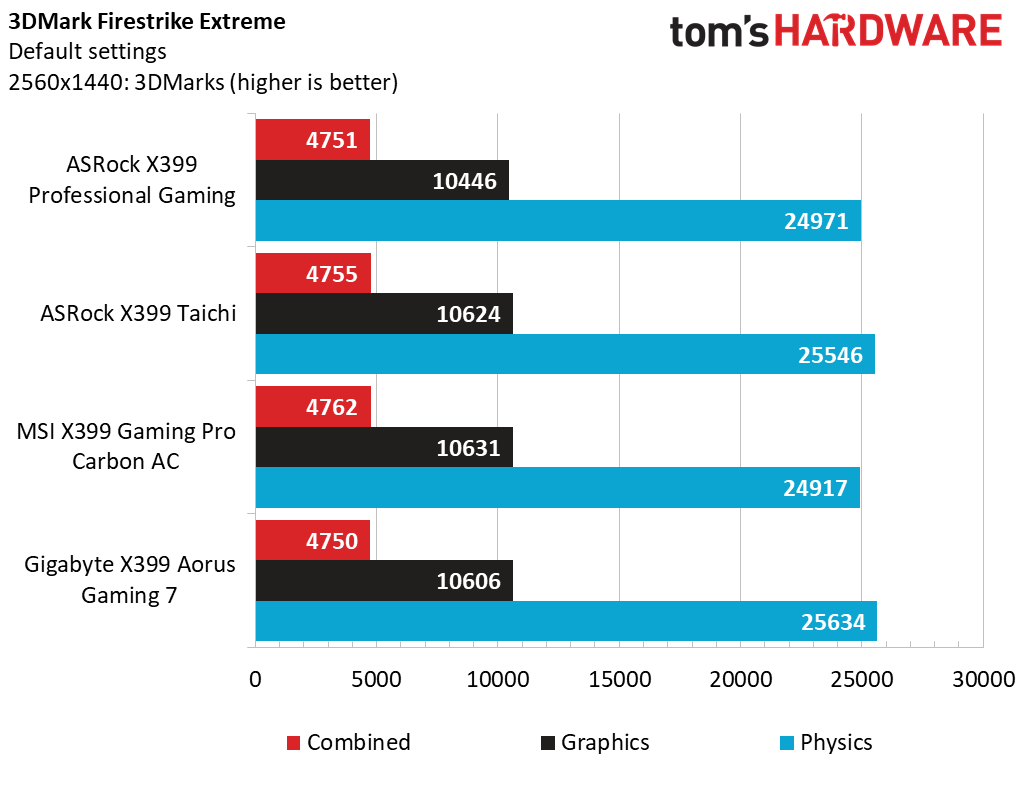
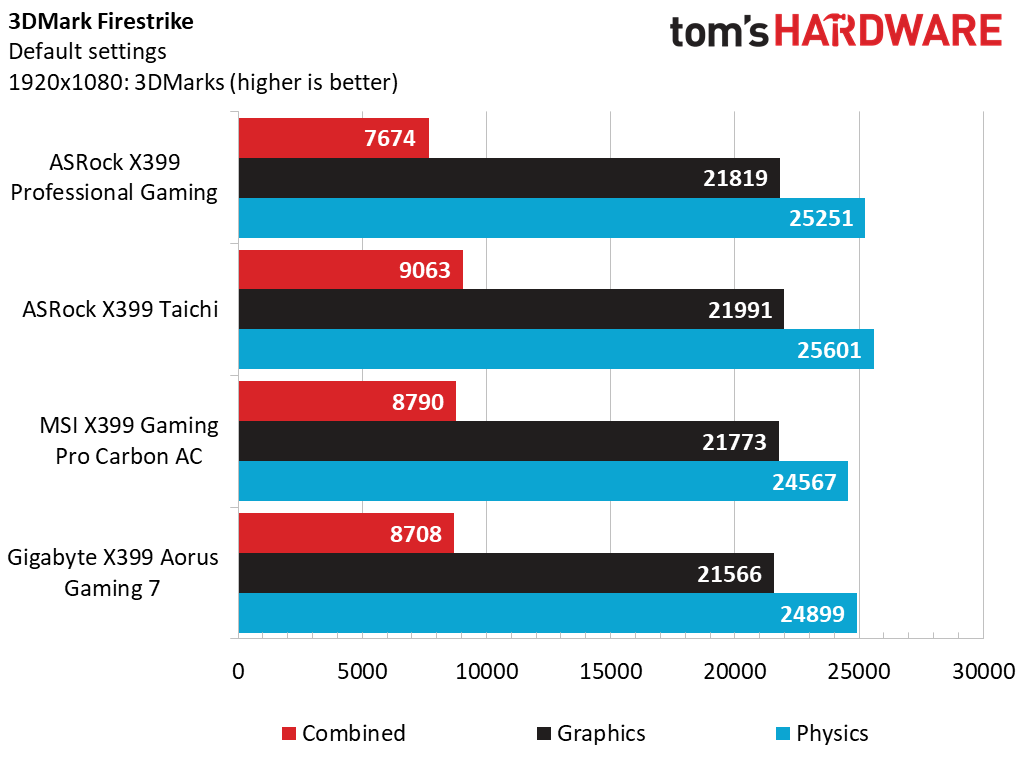
With 3DMark, we see an interesting shift in trends where the ASRock Fatal1ty board starts to slip up with regards to combined and physics scores. Unfortunately, we can’t explain the Combined score drop in Firestrike, given the test results of the graphics and physics results being positive. Otherwise, a low-third place finish in 3DMark is underwhelming for the Professional Gaming board.
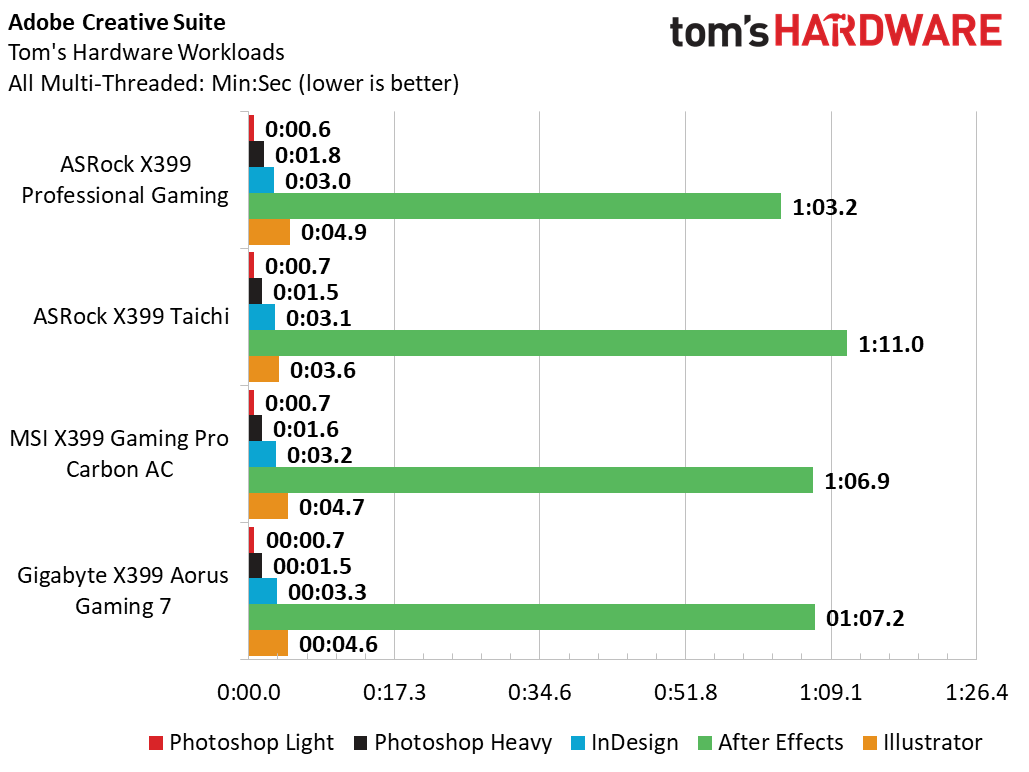
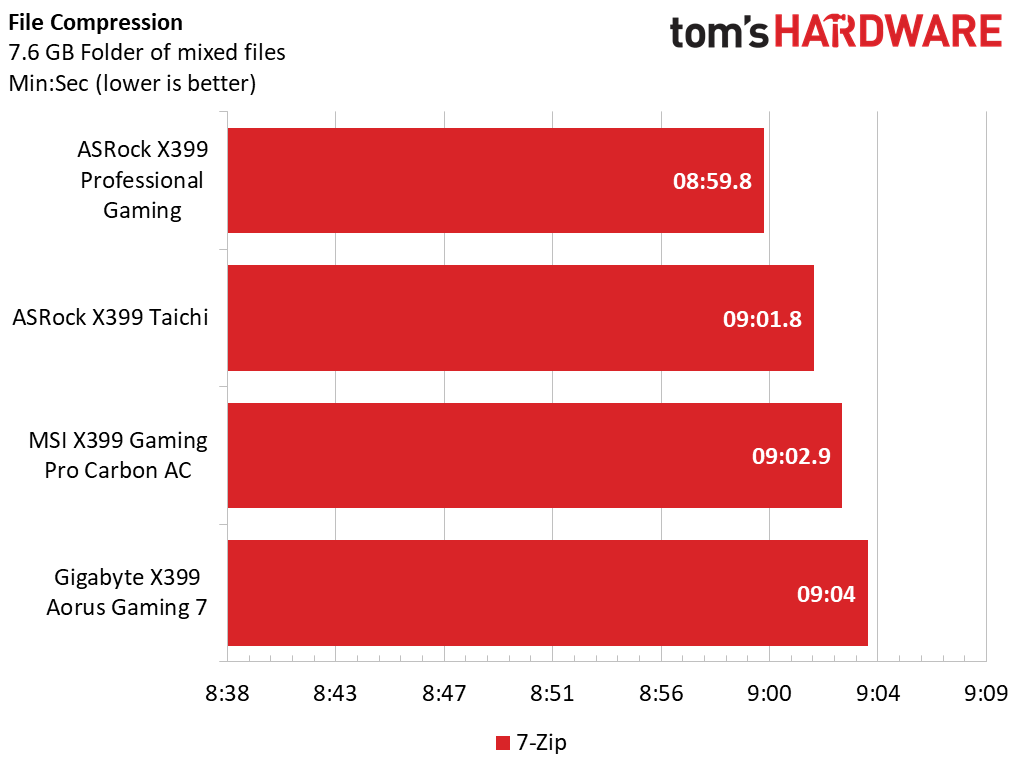
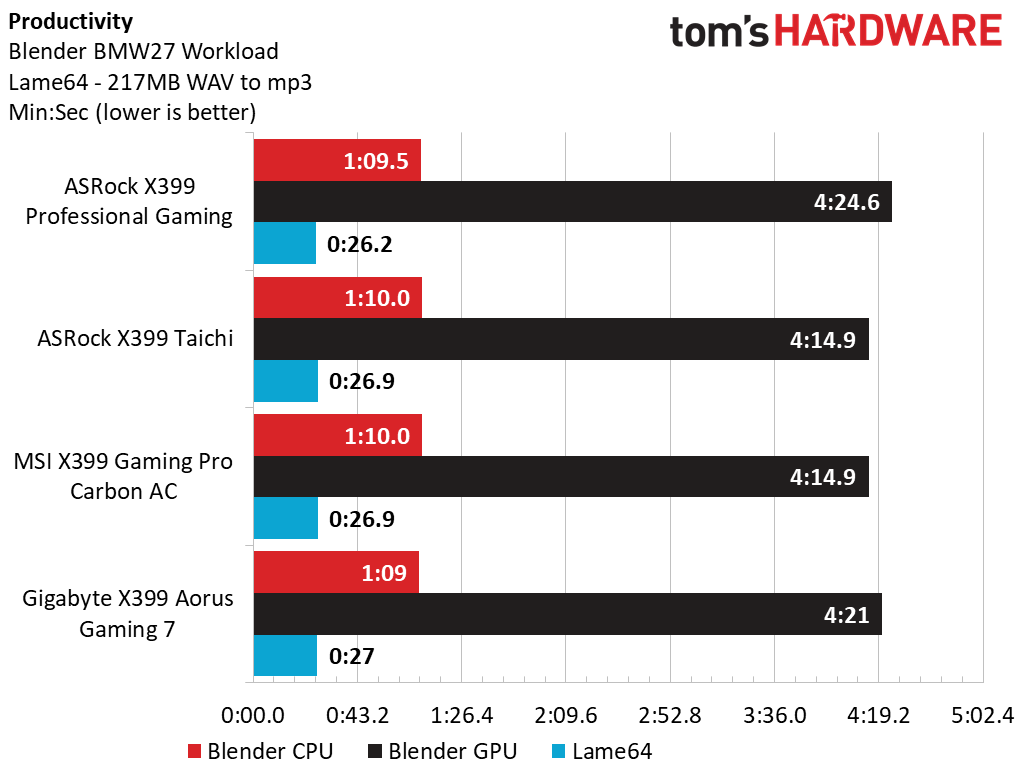
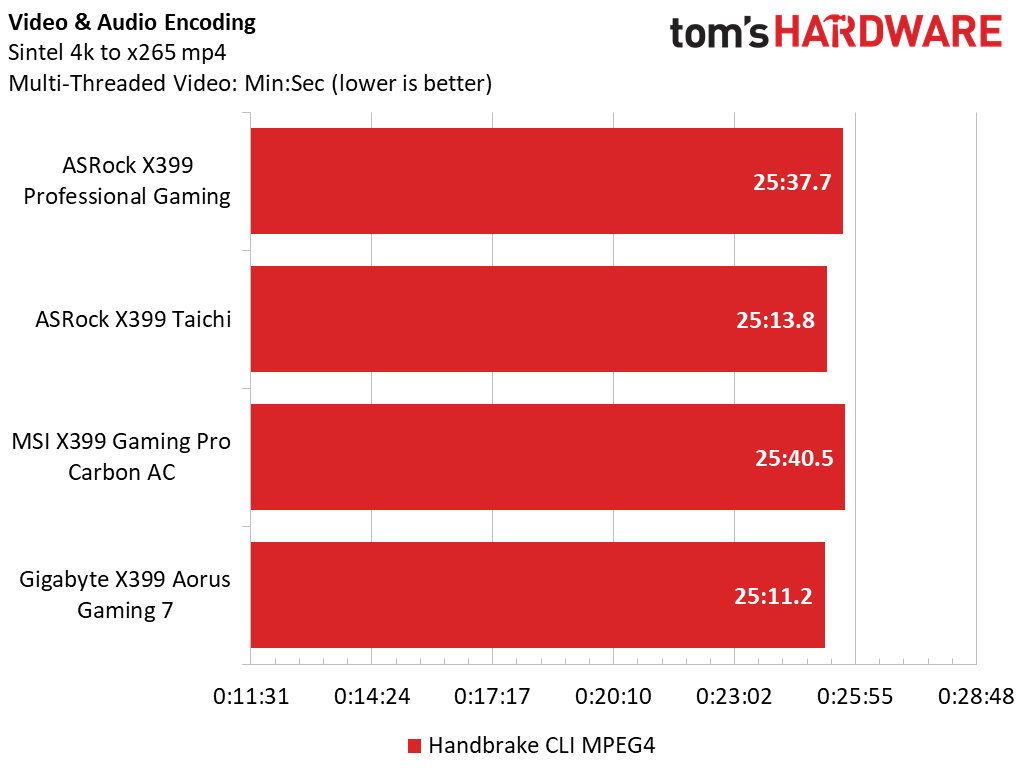
Applications, again, prove the strengths of the Threadripper platform, and the synthetic trends continue with solid wins for the Fatal1ty in Adobe, 7-zip, and some Blender runs. Although the scales in the graphs are misleading in some cases, each workload is within single-digit percentage points of each other, which shouldn’t impact overall performance metrics much.
Games and Performance
Remember how 3DMark started to show some deficiencies in the graphics department for the ASRock X399 Professional Gaming board? Those trends continue in all four of our different gaming runs, regardless of the resolution or graphical setting.
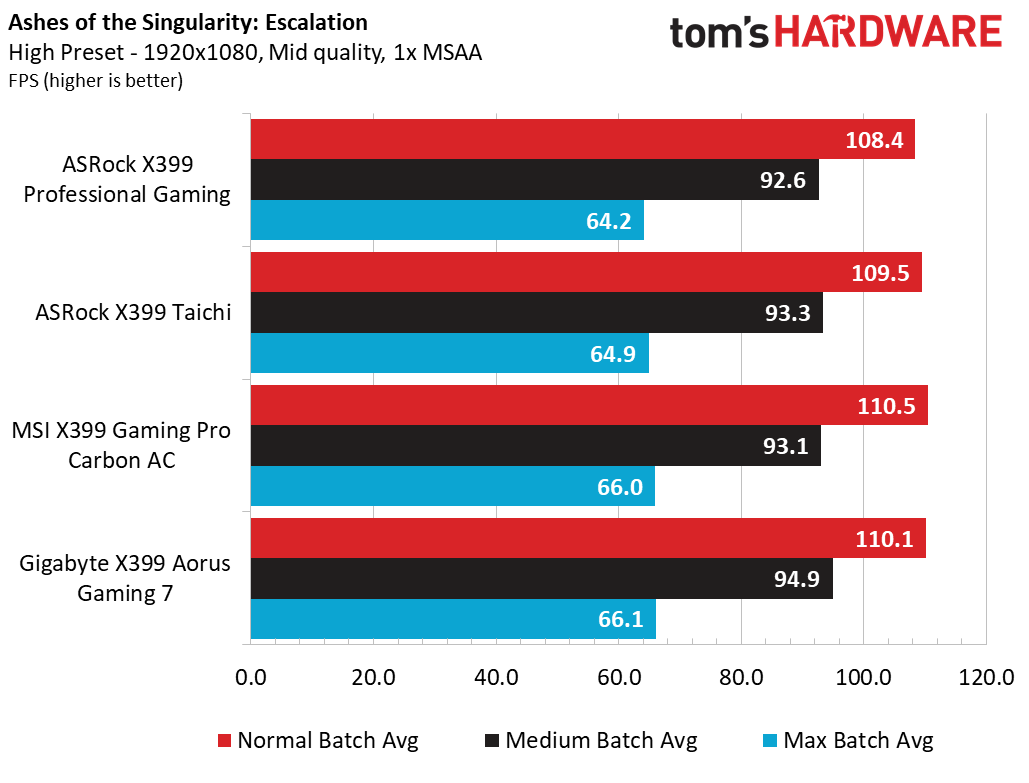
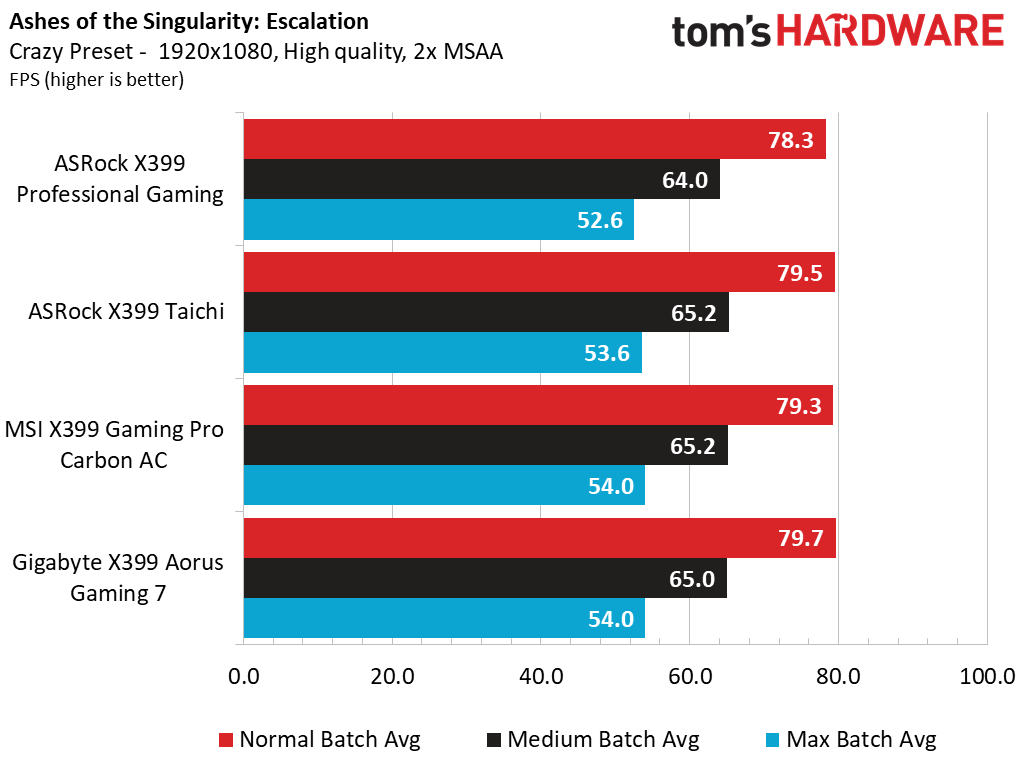
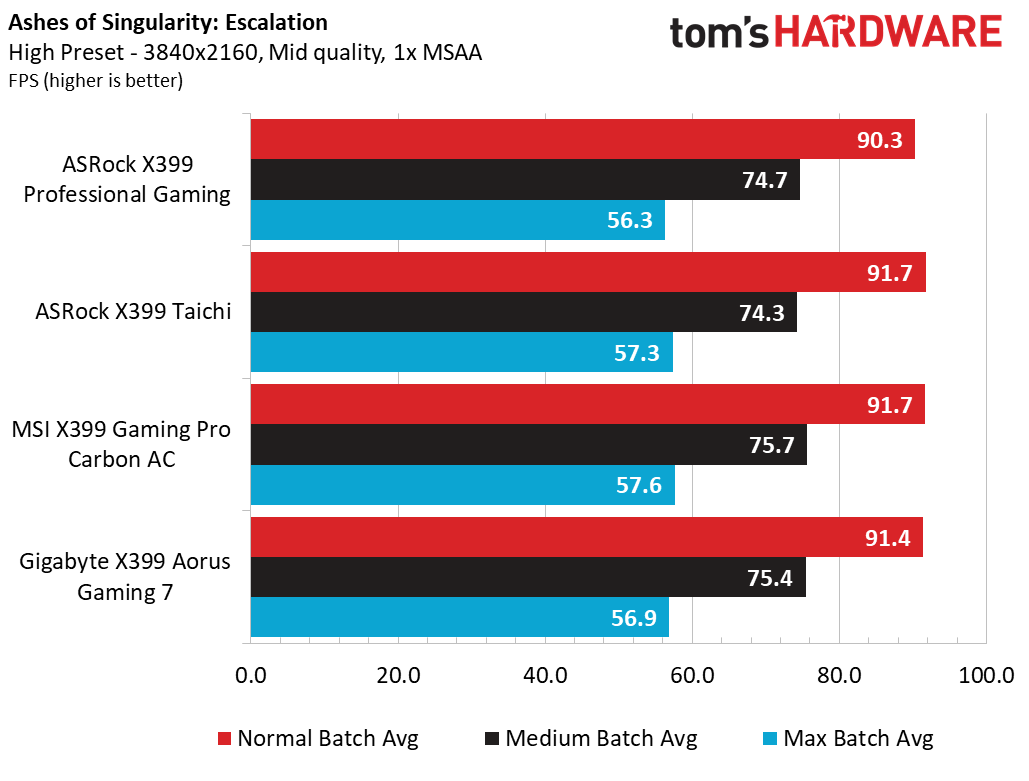
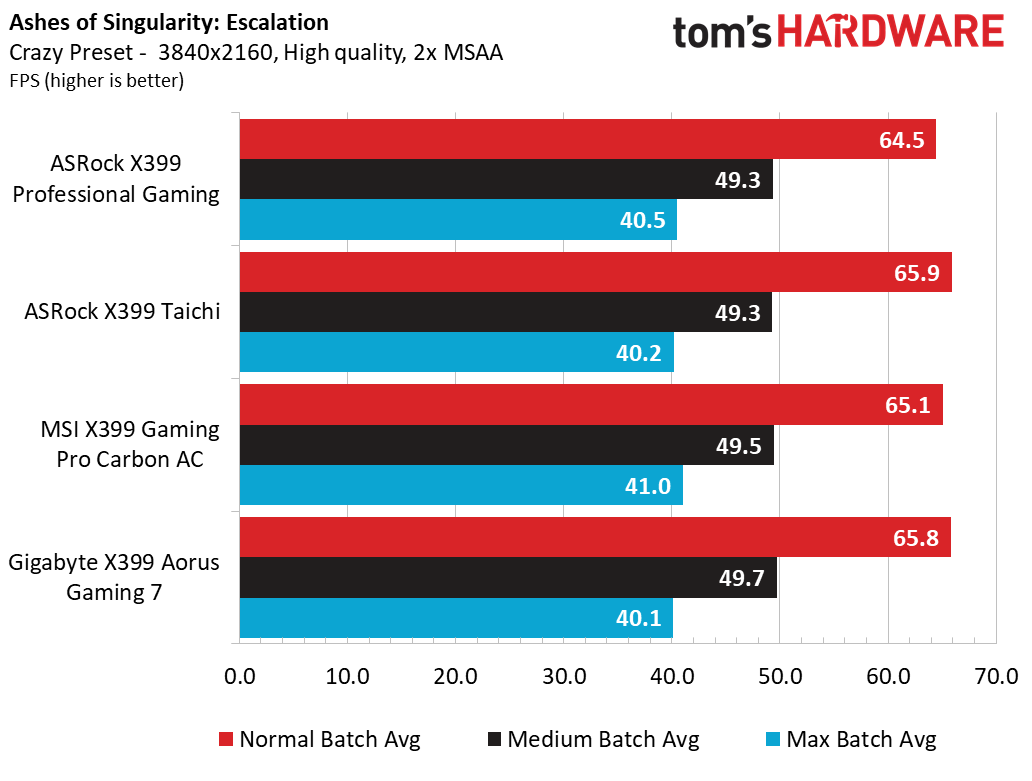
With Ashes of the Singularity: Escalation, the Gigabyte X399 Aorus Gaming 7 flies past the Fatal1ty board by up to 3 frames per second at 1080p, and the gap shrinks by a couple frames at UHD resolutions. The latter appears to be within sampling noise, so don’t draw too much concern. However, solid negative relative performance deltas will impact the Fatal1ty board's score moving forward.
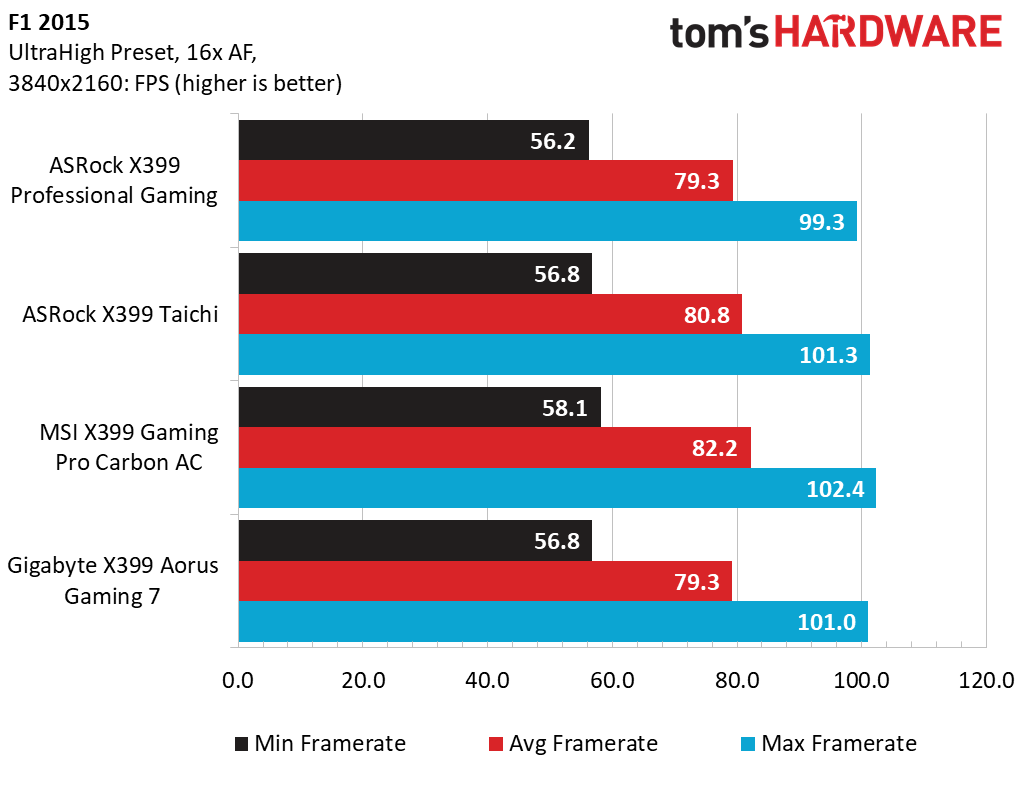
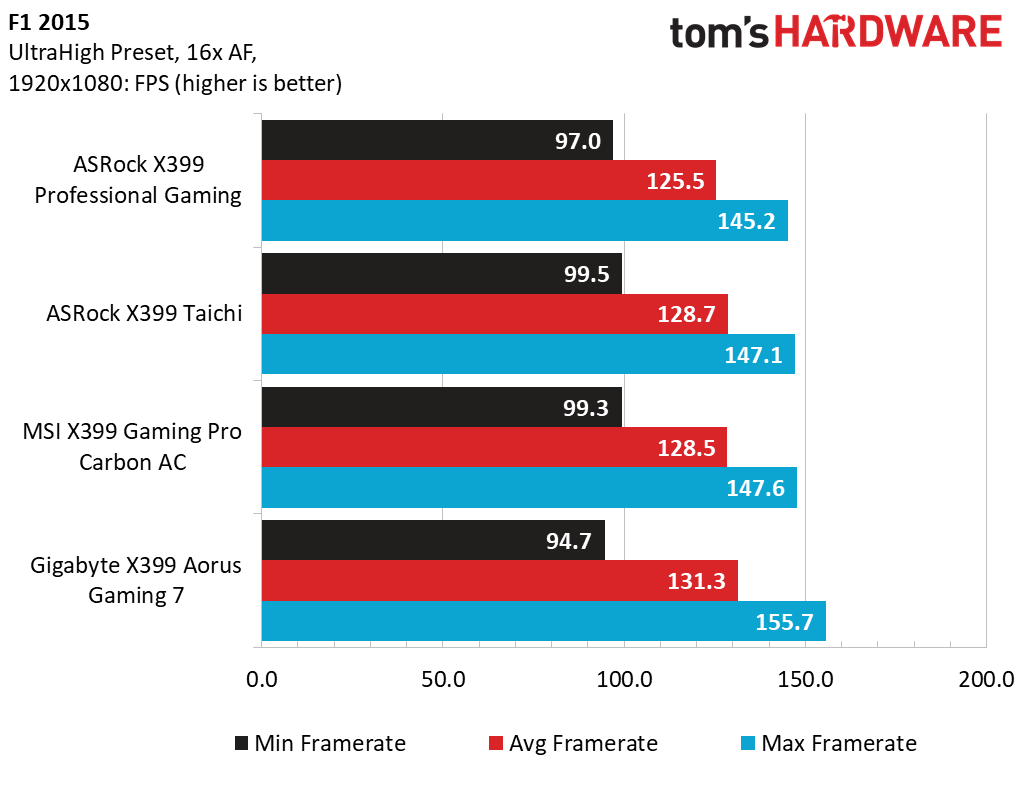
As enjoyable as F1 2015 is at all resolutions and settings with our GTX 1080, we still see frame deficiencies within 5 percentage points of the Aorus board here. Shifting to 4K reduces the deltas by a couple frames here and there, but we still see a larger percentage point gap compared to the MSI X399 Gaming Pro Carbon AC.
Get Tom's Hardware's best news and in-depth reviews, straight to your inbox.
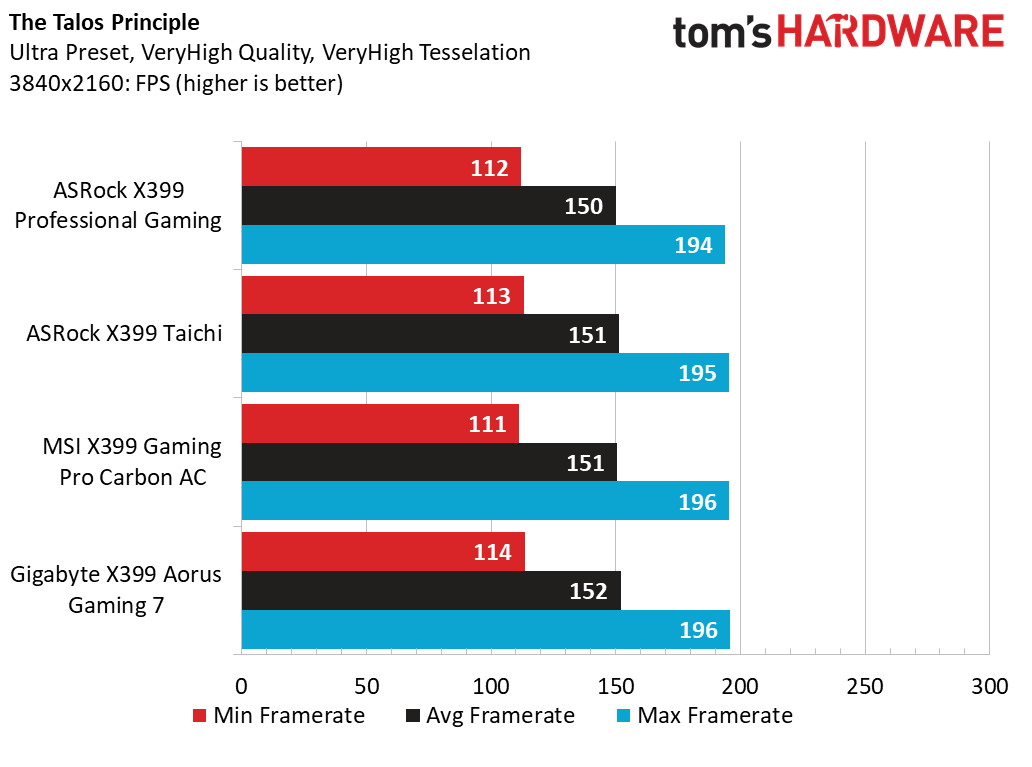

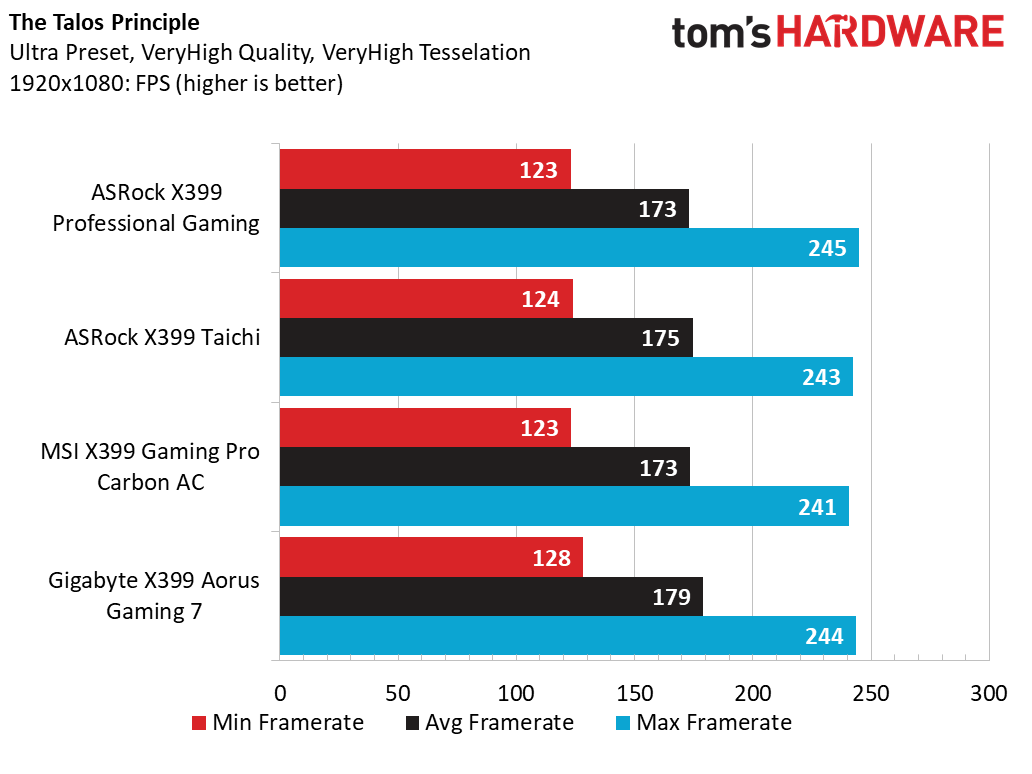
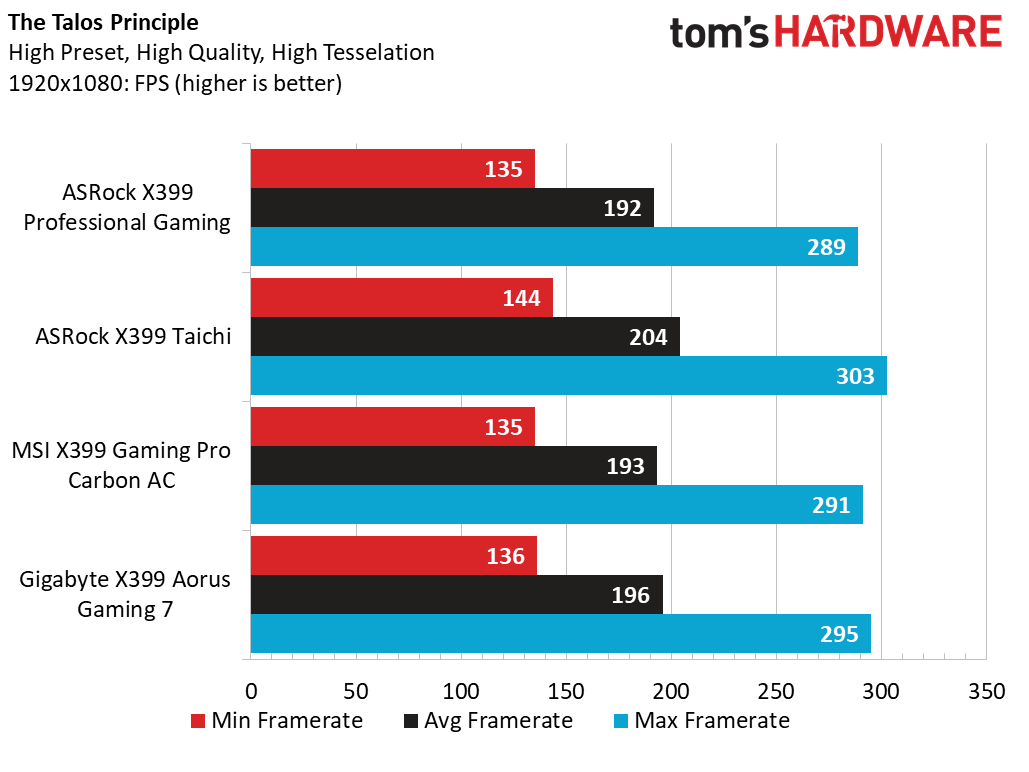
For a change of pace, the ASRock X399 Taichi starts to take the lead with The Talos Principle at 1080 high, and the Gigabyte places first with both 4K presets. The ASRock X399 Fatal1ty board still suffers from minor frame deficiencies here, but keep in mind we are talking about fewer than nine frames per second.
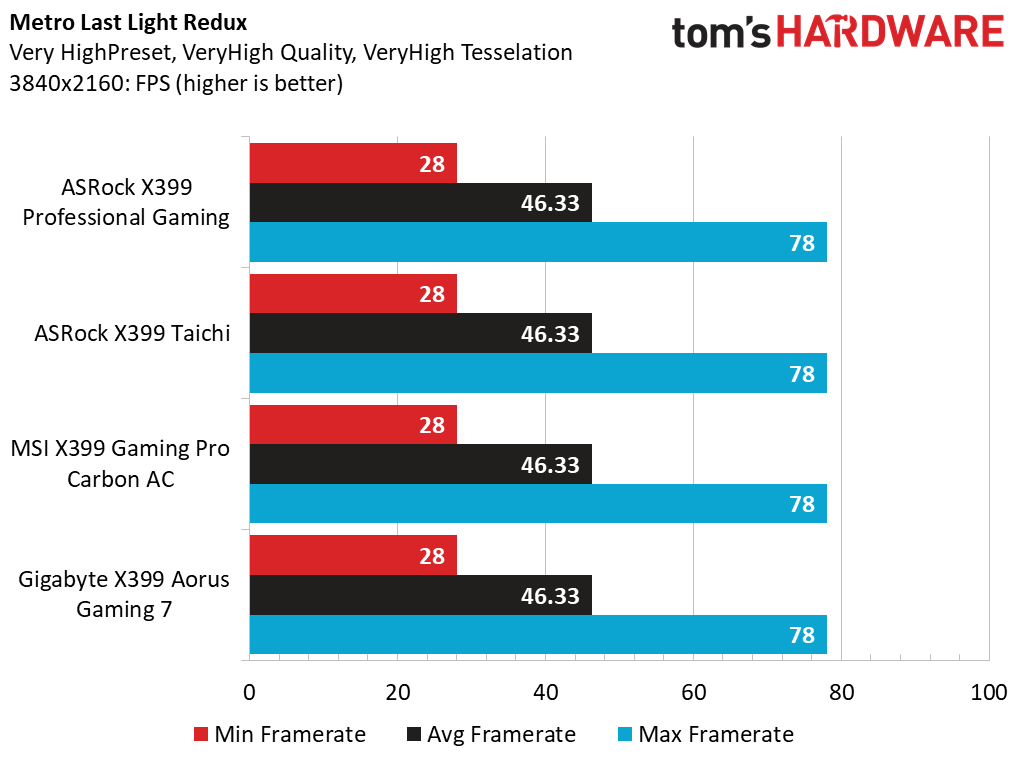
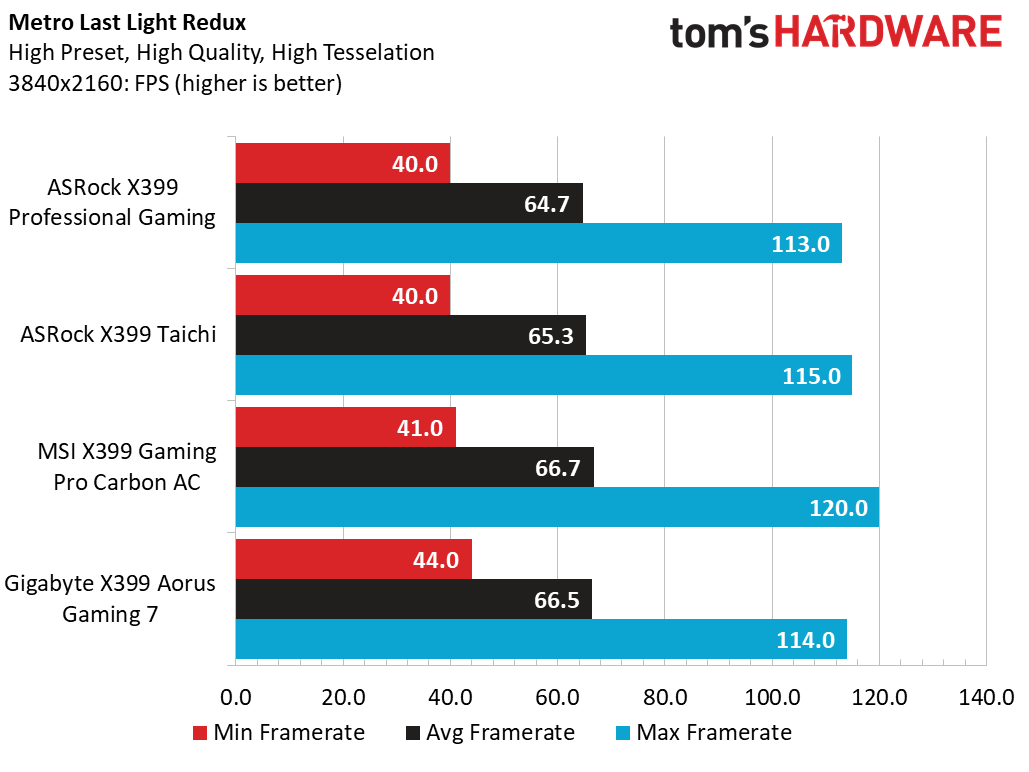
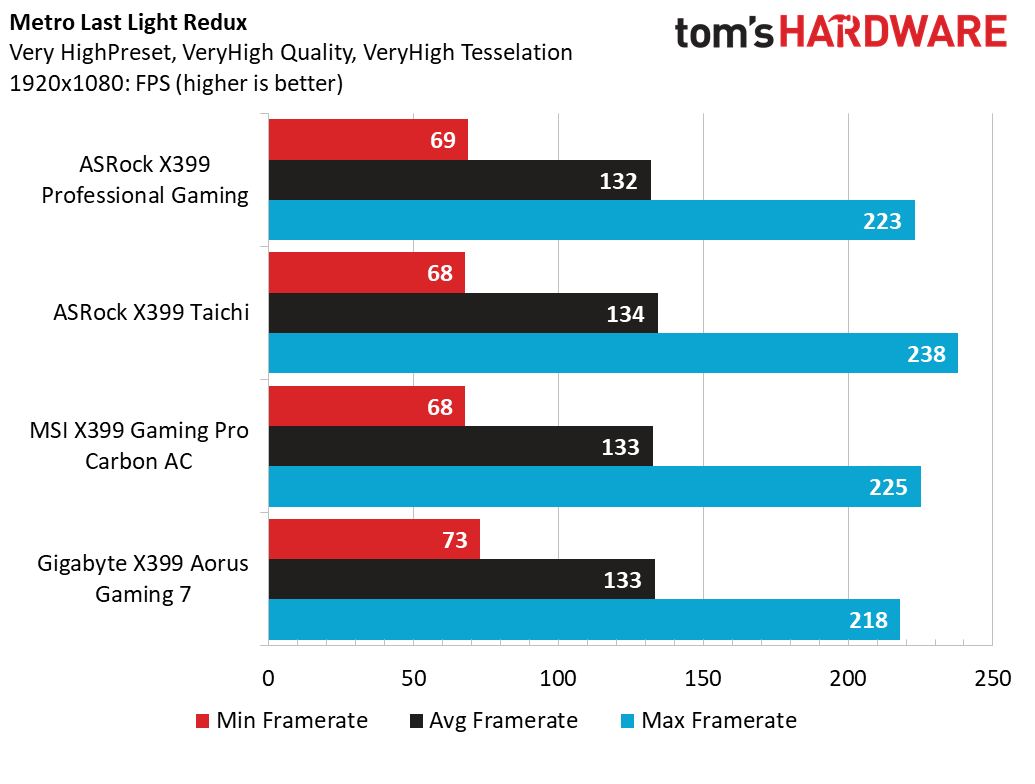
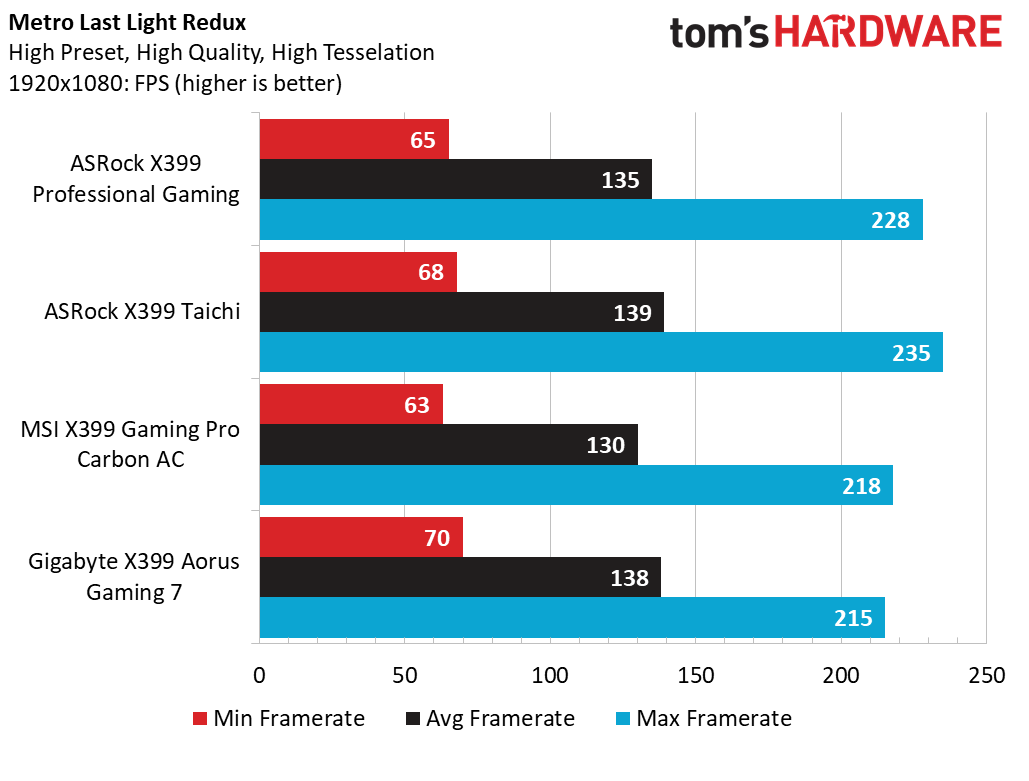
Metro Last Light scoffs at us and decides to scatter its results across all test samples, with the ASRock Professional Gaming board taking a couple first- and second-place finishes. Another way to look at the Metro results is that comparing test methodology across several months of tests, the data reflects no preference to any particular software configuration or program update discrepancies. Our 4K results also reflect this observation, with Very High presets being identical across the field and only two frames separating the Fatal1ty from the Aorus competitor.
In short, the results today are very close across all test platforms. Assigning percentages to help visualize normalized performance is both helpful and misleading at times. The ASRock Fatal1ty X399 Professional Gaming performs well in synthetic benchmarks and excellent in all application metrics, but consistently lags behind by a few frames across all gaming tests which ultimately drive its score down. If we compare against the Taichi’s results as well, we clearly see that this board design is an excellent performer, regardless of what extra features are added or removed from the final product.
MORE: Best Motherboards
MORE: How To Choose A Motherboard
MORE: All Motherboard Content
Current page: Synthetics, Applications & Games
Prev Page Test Configuration & 10Gb Teaser Next Page Overclocking – Memory, CPU, and Threadripper 2 Results-
redgarl "Tough value proposition for gamers"Reply
ARE YOU FRIGGING KIDDING ME? Aren't you the site that recommend the 9900k as a GAMING CPU with a 600$ motherboard? How is that value proposition for gamers by the way? Why not just saying that your money is better invested in a GPU than a CPU for games? Of course you didn't think it was important last Friday...
By the way, nothing about the review particularly, just the obvious double standard and lack of consistency throughout the site. -
Crashman Reply
You seem confused. Read the Z390 motherboard reviews.Then look at the byline. Then look at the byline here. The Terk is not the big-spending-gamer you're looking for. Motherboard reviewers prioritize motherboards, CPU reviewers prioritize CPUs.21420384 said:"Tough value proposition for gamers"
ARE YOU FRIGGING KIDDING ME? Aren't you the site that recommend the 9900k as a GAMING CPU with a 600$ motherboard? How is that value proposition for gamers by the way? Why not just saying that your money is better invested in a GPU than a CPU for games? Of course you didn't think it was important last Friday...
By the way, nothing about the review particularly, just the obvious double standard and lack of consistency throughout the site.
The Terk is seeing gaming situations where disabling some of the big AMD processor's cores boosts gaming performance. So maybe you're better off as a gamer to get a model with fewer cores.
Once you figure out that part, ask yourself a question: Is yours even an honest question? The 9900K review appears to offer up the 9700K as a more-realistic alternative. "The Core i7-9700K, even at stock settings, is competitive with the -9900K in most titles, especially considering the $115 you save by stepping down a notch." followed with the last sentence reading "but the (9900K's) $500 asking price relegates it to the most extreme performance enthusiasts."
-
TheTerk X399 is by no means a "value" platform, and the addition of 10Gb networking really is a tough pill to swallow. as a "gamer" would you rather get a cheaper, equivalent quality board or invest in a potentially better forward-looking network adapter. Hence "tough value proposition".Reply
Thanks for the feedback, hit me up on the community Discord if you wanna chat more about it. I'm on there a lot -
izzerwat The 'Gaming' suffix on this board is obviously silly and is best ignored. The whole TR platform is not a 'good value proposition for gamers' because gamers aren't the target audience.Reply
Its a workstation/home server/networked renderbox platform which is where the use-case value is at. For 32 cores of Zen goodness, 10gbit and decent...ish power delivery these boards and CPUs are actually remarkably cheap, compare for instance to a dual-socket, 2x16-core Intel setup.
AsRock's likely reason to stick 'gamer' on there is its associated with the Fatality brand, which they are apparently set on pairing with 10GBit controllers.
The gaming and windows benchmarks don't really agree with the 2990WX, this is known from previous reviews. Windows doesn't properly work with anything over 16-cores and ffs, don't buy a 32-core CPU for playing some vidja games.
That all said, I do think this board would have made more sense without the extraneous features. The wifi and gaming-ish features are kind of extraneous.
